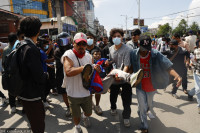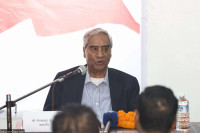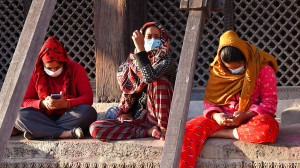Opinion
On shaky ground
In Jhapa, remittances are driving unsafe construction practices and increasing earthquake risks
Bikram Manandhar
Nepal’s natural and diverse beauty, ranging from the flatlands of the Tarai to the Himalayan mountain range, comes at a cost. This small nation is one of the most vulnerable countries, classified as a global ‘hotspot’, to natural disasters. In the first half of 2014 alone, Nepal experienced 545 recorded disaster events, which killed more than 300 people, affected more than 100,000, and cost more than $10 million. While communities in Nepal are affected by small-scale disasters on a yearly basis, a major concern is the threat of the looming large-scale earthquake. Located on a highly active seismic zone, where the Indian and Eurasian plates converge, all of Nepal is vulnerable to such an earthquake.
Increasing vulnerability
Nepal has urbanised at an alarmingly rapid and haphazard pace, becoming the fastest urbanising country in South Asia. This haphazard urbanisation, which has created unplanned cities with high population densities, has drastically increased their vulnerability to earthquakes. As past earthquake events have revealed, the majority of deaths are caused by collapsing structures. Thus, a critical component of earthquake safety is safer buildings, which can be achieved through disaster-resilient construction technologies and practices. So, Nepal has a National Building Code in place. But effective enforcement and compliance with these standards is lacking.
In order to reduce earthquake vulnerability, particularly in urban areas, the current approach has focused on the policy and legislative aspects of earthquake-resistant structures and institutional capacity to enforce these regulations. There has been less of a focus on the demand side of construction, whereby potential homeowners demand that the building of their homes follow earthquake-resilient techniques. This entails influencing individuals and potential homeowners to ensure their homes are earthquake-resilient, thus reducing vulnerability. From the household perspective, ensuring earthquake-resilient homes requires awareness of risks. However, a current gap in this area is understanding the driving force behind building construction, ie what group(s) are building homes in Nepal?
Fuelling construction
The increasing trend of labour migration for employment is making remittances a major source of income for Nepali households. According to the Department of Labour and Employment, there has been a steady increase in the total number of labour permits issued for foreign employment. A total of 2,226,152 labour permits were issued over the six-year period, representing a staggering 137 percent increase between 2008/09 and 20013/14, about eight percent of Nepal’s total population. As a result of this rapidly increasing migrant population, remittances to Nepal have soared.
Households receiving these remittances are generally in a better position to reduce poverty, increase human capital, obtain higher education levels, and help prepare for adverse shocks such as a natural disaster. According to an economic survey from 2013/14, remittance inflow attained a growth rate of 34.1 percent to Rs. 356.72 billion in the first eight months of the current fiscal year, as compared to a 22.2 percent rise in the same period of the previous fiscal year, and equaled 29.1 percent of the GDP.
The last decade has not only seen a significant increase in remittance flows to Nepal, there has also been a tremendous growth in urban areas. With increased disposable incomes, households receiving remittances have demonstrated higher likelihoods of investing in housing construction or expanding current accommodations in both urban and rural areas. Considerable amount of remittances were used by migrant households to buy land and to either construct or renovate houses than non-migrant households. However, this growth happened in an unplanned and haphazard manner, resulting in increased levels of earthquake vulnerability and continued haphazard urbanisation will only add to these impacts.
A Jhapa case study
A study conducted on remittance-receiving households in Jhapa district, which ranks as a top migrant worker-sending district with rapid population growth and rampant urbanisation, shows that there are clear linkages between remittances and building construction practices. A high percentage (22 percent) of money received within last 12 months from a family member working abroad for foreign employment was allocated to construction-related practices (building a new home, addition of a floor, and repair of an existing home). An important aspect of safer building is the use of professional engineers in the design and constructions of houses, but 58 percent of remittance-receiving households did not use an engineer while constructing their homes. The study showed the intent to build a new house is significantly higher for remittance-receiving households where 52 percent of households receiving remittances expressed their intention to build a new house in the next two to five years.
Likewise, awareness of the existence of building codes also remains low. Such lack of awareness about building codes leads to the reasonable assumption that the construction of homes does not prioritise earthquake safety. Despite this lack of awareness on building codes, 63 percent of households in Jhapa expressed confidence that their homes were safe from earthquakes. This highlights the need to strengthen awareness for safer construction to address what may be a false sense of security in the structural integrity of houses in Nepal.
In conclusion, remittance-dependent households are investing a significant portion of remittances in construction practices, from building new homes to adding floors or repair. In addition, they are more likely to build a new house in the next two to five years. Due to the combination of remittance utilisation for construction practices with an overall low awareness of building codes and the failure to employ an engineer for construction, it can be concluded that remittances are driving unsafe construction practices and increasing earthquake risks, at least in Jhapa. This highlights the need for the government and NGOs to come up with a more concerted effort to ensure greater public awareness and demand building code compliance for safer buildings.
Manandhar is a research officer and consultant with Practical Action. This article is a part of research project, ‘Understanding the role of remittances in reducing risk to earthquakes’, conducted by Practical Action in partnership with the Nepal Risk Reduction Consortium ([email protected])




 14.12°C Kathmandu
14.12°C Kathmandu








%20(1).jpg&w=300&height=200)

